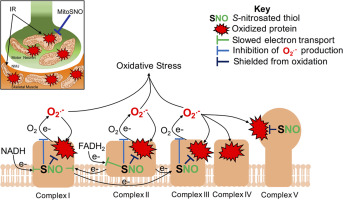Free Radical Biology and Medicine ( IF 7.1 ) Pub Date : 2018-02-09 , DOI: 10.1016/j.freeradbiomed.2018.02.006
Rebecca J Wilson 1 , Joshua C Drake 2 , Di Cui 2 , Bevan M Lewellen 2 , Carleigh C Fisher 2 , Mei Zhang 3 , David F Kashatus 4 , Lisa A Palmer 5 , Michael P Murphy 6 , Zhen Yan 7

|
Deterioration of neuromuscular junction (NMJ) integrity and function is causal to muscle atrophy and frailty, ultimately hindering quality of life and increasing the risk of death. In particular, NMJ is vulnerable to ischemia reperfusion (IR) injury when blood flow is restricted followed by restoration. However, little is known about the underlying mechanism(s) and hence the lack of effective interventions. New evidence suggests that mitochondrial oxidative stress plays a causal role in IR injury, which can be precluded by enhancing mitochondrial protein S-nitrosation (SNO). To elucidate the role of IR and mitochondrial protein SNO in skeletal muscle, we utilized a clinically relevant model and showed that IR resulted in significant muscle and motor nerve injuries with evidence of elevated muscle creatine kinase in the serum, denervation at NMJ, myofiber degeneration and regeneration, as well as muscle atrophy. Interestingly, we observed that neuromuscular transmission improved prior to muscle recovery, suggesting the importance of the motor nerve in muscle functional recovery. Injection of a mitochondria-targeted S-nitrosation enhancing agent, MitoSNO, into ischemic muscle prior to reperfusion reduced mitochondrial oxidative stress in the motor nerve and NMJ, attenuated denervation at NMJ, and resulted in accelerated functional recovery of the muscle. These findings demonstrate that enhancing mitochondrial protein SNO protects against IR-induced denervation at NMJ in skeletal muscle and accelerates functional regeneration. This could be an efficacious intervention for protecting neuromuscular injury under the condition of IR and other related pathological conditions.
中文翻译:

线粒体蛋白S-亚硝化可防止骨骼肌神经肌肉接头处缺血再灌注诱导的去神经支配
神经肌肉接头 (NMJ) 完整性和功能的恶化会导致肌肉萎缩和虚弱,最终影响生活质量并增加死亡风险。特别是,当血流受到限制然后恢复时,NMJ 很容易受到缺血再灌注 (IR) 损伤。然而,人们对潜在机制知之甚少,因此缺乏有效的干预措施。新证据表明,线粒体氧化应激在 IR 损伤中起着因果作用,可以通过增强线粒体蛋白S-亚硝化 (SNO) 来预防这种损伤。为了阐明 IR 和线粒体蛋白 SNO 在骨骼肌中的作用,我们利用了临床相关模型,结果表明 IR 会导致显着的肌肉和运动神经损伤,并有证据表明血清中肌肉肌酸激酶升高、NMJ 去神经支配、肌纤维变性和肌纤维变性。再生,以及肌肉萎缩。有趣的是,我们观察到神经肌肉传递在肌肉恢复之前得到改善,这表明运动神经在肌肉功能恢复中的重要性。在再灌注前向缺血肌肉中注射线粒体靶向S 亚硝化增强剂 MitoSNO,可减少运动神经和 NMJ 中的线粒体氧化应激,减弱 NMJ 的去神经支配,并加速肌肉的功能恢复。这些发现表明,增强线粒体蛋白 SNO 可以防止 IR 诱导的骨骼肌 NMJ 去神经支配,并加速功能再生。这可能是在 IR 和其他相关病理条件下保护神经肌肉损伤的有效干预措施。































 京公网安备 11010802027423号
京公网安备 11010802027423号